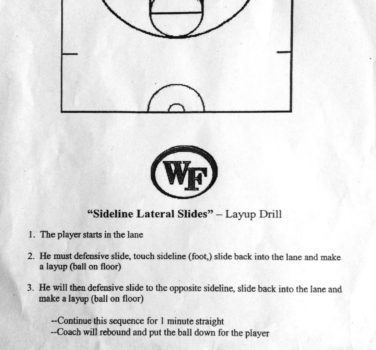Basketball Basics and Rules
When basketball was officially invented by James Naismith in 1896, there were only thirteen rules and one of those rules was that the player with the ball was not allowed to run with the ball.
Imagine that?
Obviously the game has changed quite a bit in the last hundred years and basketball today is a completely different sport. Just think about the number of basketball rules that have expanded exponentially.
In fact, the game has become complicated enough to where there are still numerous debates amongst basketball fanatics about how certain rules should be interpreted.
This guide is meant to help those unfamiliar, and some of those who are familiar, understand the game of basketball better.
The Absolute Basics
The absolute fundamentals to the game of basketball is five players per team on the court, one ball, two hoops at exactly ten feet above the ground on posts, standardized backboards, and a shot clock that forces teams to take a shot or turn the ball over to the other team in a short period of time.
A shot from inside the three-point line is worth two points and three points from outside that same line. Every free throw is worth one point. Aside from these universal precepts, the rules of basketball change slightly through the different levels of competition, namely NCAA (National Collegiate Athletic Association), FIBA (International Basketball Federation), and the NBA (National Basketball Association).
Detailed below are the fundamentals of basketball and their variations throughout the four main levels of competition.

1. The Court
Every single game of competitive basketball is played on a rectangular court that is divided by a line in the exact middle called the mid-court line. The exact dimensions of the basketball court and there various markings change depending on the level of competition including everything from exact length and width to the distance of the three-point line from the hoop.
2. Positions
Traditionally, a basketball team is made up of a starting five consisting of:
Point Guard
Primary ball handler and play maker, the one position
Shooting Guard
Generally plays off the ball and is a scoring threat, the two position
Small Forward
Typically taller than a guard but faster than a power forward, most versatile position, the three position
Power Forward
Tall and strong, traditionally strong post players, the four position
Center
Usually the tallest and biggest player on the team, meant as a defensive anchor and best post presence, the five position
For those unfamiliar with the terminology, a “post player” is someone who plays primarily in the paint with their back to the basket and they generally rely on their strength, height, and finesse to force their way into the paint and score.

3. Timing
In basketball, timing is everything. The game itself is so fast paced and demands completely focus and one of the things every player on the court has to be aware of is the various time-based restrictions. The first and most important restriction is the length of the game.
In the NBA, the game is made up of four twelve-minute quarters, four ten-minute quarters in FIBA, and two twenty-minute halves in the NCAA. Also one needs to remember the shot clock forces teams to take a shot or turn the ball over in a short period of time. In the NBA and FIBA, the shot clock is 24 seconds long while it is 35 seconds in collegiate play.
4. Double-dribbling is a violation when a player moves the ball into the air or to the ground after they have touched the ball with both hands, if they stop dribbling the ball without losing possession of it, or if they touch the ball more than once before it hits the ground. If a player commits a double dribble they immediately turn possession over to the other team.
5. Following the eventually allowance of running with the ball in 1922, Traveling became a violation in which a player takes more than two steps without dribbling. A player can also travel if they pick up their dribble, establish a pivot foot and then pick up their pivot.
For those unfamiliar with the terminology, a pivot foot is when a player stops dribbling and cannot dribble again without double dribbling, so they rotate on a foot that they cannot lift off the ground. It allows for a trapped player to gain room to make a pass without traveling.
6. Fouling is simply any illegal contact and is one of the most controversial aspects of the game, as is the case in most professional sports, and there are many different circumstances surrounding what makes contact an offensive foul or a defensive foul.
There are many different types of offensive and defensive fouls but the most common are blocking fouls, which are committed by the defense, and charges which are offensive violations. The NBA defines the differences between the fouls as thus:
“A block/charge foul occurs when a defender tries to get in front of his man to stop him from going in that direction. If he does not get into a legal defensive position and contact occurs, it is a blocking foul. If he gets to a legal position and the offensive player runs into him it is an offensive foul.”
There are many nuances to what constitutes “legal position” and it is a constant struggle for referees to make the correct call during such a fast paced sport. There is a current push in the NBA for referees to recognize the element of “verticality” which is when a defensive player makes contact with an offensive player in their shooting motion but they remain completely vertical with their arms and body and do not invade the space of the shooter.
This is not considered a defensive foul and is controversial and many offensive players feel that any contact should be considered a foul. Here is a video of current Pacers center Roy Hibbert maintaining verticality.
Other fouls include:
-
- Hitting or slapping a player, which generally results in a flagrant foul and/or an ejection from the game
- Flagrant fouls, which were just mentioned, are considered excessive personal fouls that are generally violent. Flagrant fouls mean automatic free throws for the other team and they keep possession after the free throws.
- Holding a player from moving
- Setting an illegal pick, which is generally a result of a pick-setter moving to keep blocking the defender
- Technical fouls, which are behavior-related fouls and relate to sportsmanship. Technical fouls are very controversial as they are vaguely defined and up to the discretion of the officials
Fouling also results in free throws if a player is fouled during their shooting motion or if their team has accumulated above the limit of fouls in a designated time period, either quarters or halves depending on the level of competition.
If a player is fouled in the act of shooting, they are awarded the number of free throws equivalent to the amount of points the shot would have been worth if made, either two or three. Free throws were a part of the game from its very beginning.
While this is a fairly comprehensive summary of the rules of basketball, there are countless nuances and minor rules that are still necessary for those wishing to acquire a better understanding of the game. For those looking for more resources, here are links to the NBA, NCAA, and FIBA‘s official rulebooks.
What are some other basic rules about the game of basketball that people should know?







basketbalschoenen
Hey Lamar Hull. Your article has highlighted all useful points. Its a good guide for those who are unfamiliar with the game’s rules. Very interesting!
Lamar Hull
Thanks for the feedback. That is great insight and Inspirational Basketball’s plan is to continue to provide valuable basketball information!